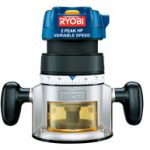We may receive a commission when you use our affiliate links. However, this does not impact our recommendations.
What tables, workbenches and horses would you have if your shop had an unlimited amount of floor space? I would have several at different heights for different tasks, each sturdy and solid, with flat surfaces and convenient places for clamping. One would be about counter height for routing and preparing parts, one would be about 2′ off the floor for assembly work, and one would be in between these two heights.
A bigger shop might be out of reach, but having the means of putting the work at just the right height, even in the smallest of shops, is pretty simple. Instead of making several different benches and horses, I devised a system of two boxes that can be used three different ways. A pair of plywood I-beams connects the boxes, providing a larger and more solid surface. These can be used to support the work directly, or to support a plywood work surface. When they aren’t needed, all four pieces can be stored away in just a few square feet of space.

When the individual frames have been assembled, they are glued and screwed together to form a box.
Each box is made of two pairs of wood frames, with a 3⁄4″-thick plywood cap on the ends. The boxes’ finished dimensions are 16″ x 22″ x 30″.
I assembled the frames with pocket screws and glue. The corners between the frames are glued butt joints. I held the butt joints together with a few narrow-crown staples while I drilled holes and drove #8 x 13⁄4″ screws. The plywood ends are also attached with glue and screws. I cut the plywood 1⁄8″ oversize in both directions, and I made sure I had a square corner. After I fastened down the square corner, I pulled the frame to line up with the plywood. After the glue had dried, I trimmed the excess plywood with a flush-trimming bit in the router.
The I-beams are made from three 43⁄4″-wide strips of 3⁄4″-thick plywood. The top and bottom have a 1⁄4″-deep groove down the middle, and the third component is glued into the grooves. All of these sizes can be varied to suit your needs, but the ones listed get all the plywood pieces you need for the beams and the box ends from a single sheet of 3⁄4″ plywood.
The beams could be simply nailed or screwed together, but a 1⁄4″-deep groove the length of the top and bottom pieces makes it easier to center the middle piece. After a few test cuts to match the width of the dado set to the thickness of the plywood, I cut the grooves, ran a bead of glue down the middle of the groove and assembled the beams. I fastened them with 11⁄2″-long narrow crown staples. Finish nails, brads or screws could just as easily be used.

With the plywood ends attached, the boxes are put in service to assemble the beams.
The sizes were chosen to provide a stable platform at various heights, whether the horses are used individually or in pairs. Here are just a few of the ways I have used the horses:
– 30″ high – temporary stand for chop saw
– 22″ high – horse for hand sawing
– 22″ high – stand for benchtop planer
– 30″ high (plus beams) – a bench that’s roughly kitchen-counter height
– 22″ high (plus beams) – an assembly table roughly dining-table height
– 16″ high (plus beams) – low assembly table for furniture or cabinets
– 16″ or 22″ high (plus beams) – bench for rough-cutting sheet goods with circular saw
– Beams alone can be used to make a level platform on the floor for cabinets or furniture
– When working on small pieces, like a carving, I can sit on one horse at 22″ high and clamp my work on a second horse at 30″.
When using the beams to cut plywood, I turn them 90° so the saw cuts into the narrow edges (as shown above). This avoids the risk of hitting one of the fasteners that hold the beam together. Most of the time gravity is sufficient to make a useful work surface, but for a more stable, semi-permanent function, the beams and horses can be connected with a few screws.
Click here for a PDF of the project plans and cutlist. WM
Here are some supplies and tools we find essential in our everyday work around the shop. We may receive a commission from sales referred by our links; however, we have carefully selected these products for their usefulness and quality.






![Bringing the 1955 Crescent Band Saw to Life! [Video]](http://www.popularwoodworking.com/wp-content/uploads/bfi_thumb/dummy-transparent-olcy6s63it1p9yp7uhusjas7c8kahafrhg9su7q9i0.png)

